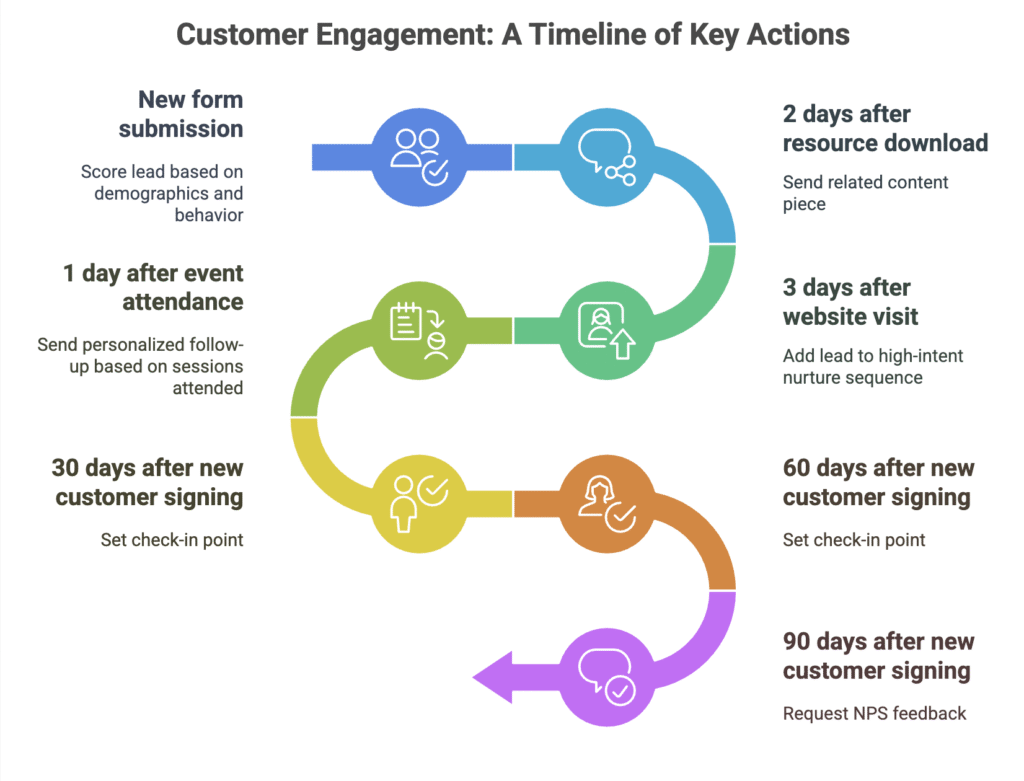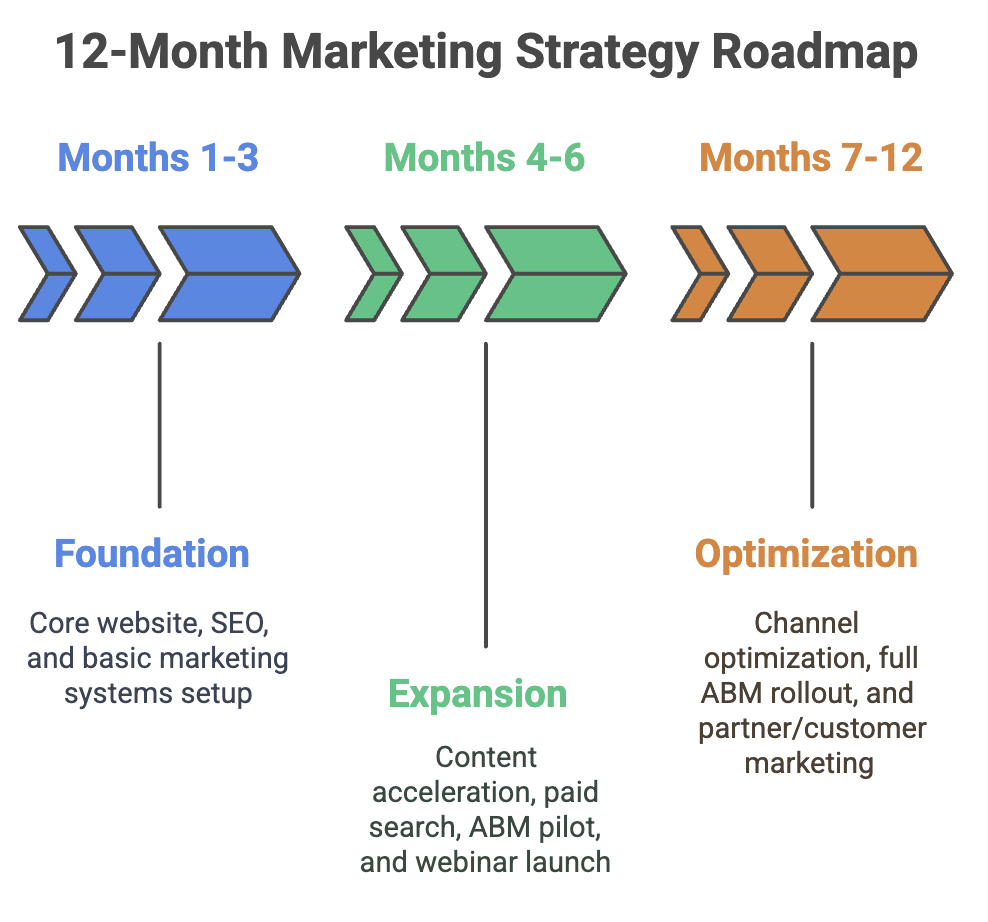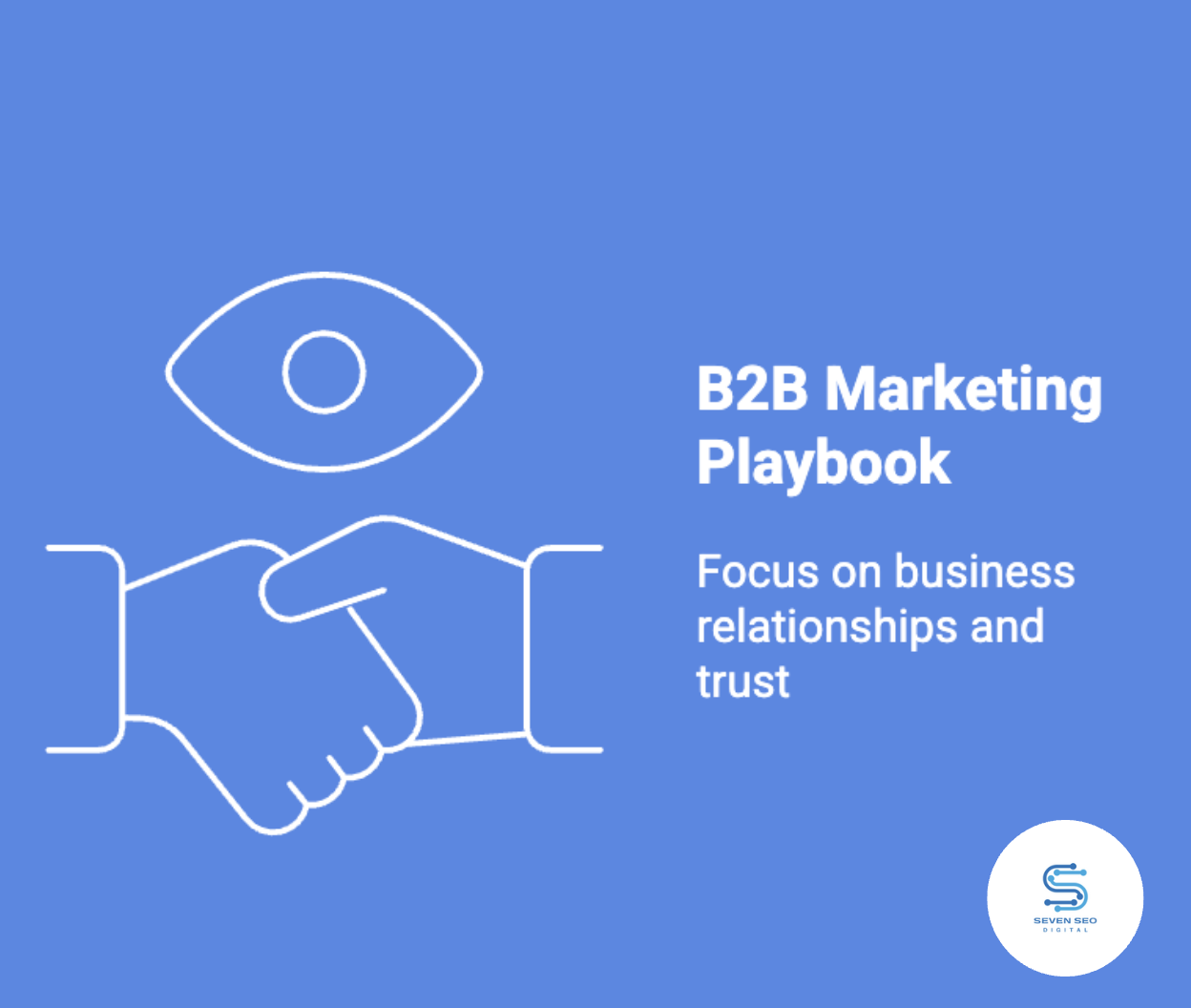B2B marketing has transformed from simple lead generation into a sophisticated, multi-channel endeavor requiring strategic precision and technological integration. For founders looking to scale their B2B startups, understanding the full spectrum of marketing strategies has become non-negotiable for sustainable growth.
This playbook is designed specifically for founders navigating the growth stage of their B2B businesses. We’ll explore proven marketing strategies, examine effective distribution channels, demonstrate how to leverage automation, and provide industry benchmarks to measure your success against.
Understanding the Modern B2B Marketing Landscape
Today’s B2B buyers are more informed, conduct extensive research independently, and often prefer digital touchpoints before engaging with sales representatives. This shift necessitates a fundamental change in how B2B companies approach marketing.
Key Characteristics of Modern B2B Marketing
- Longer Sales Cycles: The typical B2B buying process involves multiple decision-makers and can extend from 3 to 12+ months depending on solution complexity.
- Account-Based Focus: Treating key accounts as markets of one, with personalized content and outreach.
- Content-Driven Education: Today’s B2B buyers consume 13+ pieces of content before making a purchase decision.
- Digital-First Engagement: 70% of the B2B buying process now happens before a prospect speaks to a sales representative.
- Data-Driven Decision Making: Successful B2B marketing relies heavily on analytics to optimize campaigns and demonstrate ROI.
Understanding this facts is the foundation upon which all your marketing strategies should be built.
Core B2B Marketing Strategies for Scale
For B2B startups in the growth stage, these core strategies form the backbone for complete marketing approach:
Account-Based Marketing (ABM)
ABM inverts the traditional marketing funnel by identifying high-value accounts first, then creating personalized campaigns specifically for them.
Implementation Approach:
- Identify 50-100 ideal customer profile (ICP) companies
- Research key stakeholders within each account (typically 6-10 decision-makers)
- Create personalized content addressing specific pain points for each role
- Coordinate multi-channel outreach efforts across marketing and sales
- Measure engagement at the account level rather than individual lead metrics
Growth Stage Application: Focus 40% of marketing resources on ABM for enterprise accounts that can deliver 3-5x your average contract value.
Content Marketing and Thought Leadership
B2B decisions are inherently risk-averse, making educational content critical for building trust and demonstrating expertise.
Strategic Framework:
- Top of Funnel: Industry reports, trend analyses, and educational content addressing broader market challenges
- Middle of Funnel: Solution-comparison guides, case studies, and methodologies for evaluating options
- Bottom of Funnel: Technical documentation, implementation guides, and ROI calculators
Distribution Mechanisms:
- Gated premium content for lead generation
- Ungated thought leadership for brand awareness
- Repurposed content across multiple channels (blog → webinar → social snippets → email course)
Growth Stage Application: Allocate 25-30% of marketing budget to content creation and distribution, with particular emphasis on case studies demonstrating measurable results with companies similar to your prospects.
Search Engine Optimization
Despite changing algorithms, SEO remains one of the highest-ROI activities for B2B companies due to the research-intensive nature of B2B buying.
Strategic Approach for B2B SEO:
- Focus on long-tail, high-intent keywords related to your specific solutions
- Create in-depth content (2000+ words) addressing complex industry challenges
- Build backlink profiles through industry partnerships, guest posting, and digital PR
- Optimize technical SEO for mobile devices and page speed
- Target featured snippets for high-value informational queries
- Prioritise generative engine optimization, and AI overviews
Growth Stage Application: Develop SEO clusters around your core solutions, with comprehensive pillar pages supported by related subtopic content.
Strategic Partnerships and Ecosystem Marketing
B2B purchases rarely happen in isolation, they must integrate with existing systems and processes. Building a partnership ecosystem creates multiple paths to market.
Partnership Types:
- Technology Integrations: Building connectors to complementary platforms
- Co-Marketing Partnerships: Joint content creation and campaign execution
- Channel Partnerships: Resellers, consultants, and implementation partners
- Industry Affiliations: Association memberships and certification programs
Growth Stage Application: Identify 5-7 strategic partners with complementary offerings and overlapping customer bases for co-marketing initiatives.
Customer Marketing and Advocacy
Existing customers represent both retention opportunities and potential expansion revenue. A formalized customer marketing program can decrease churn while driving referrals.
Program Elements:
- Customer success stories and case studies
- User groups and community building
- Referral incentive programs
- Customer education and enablement
- Expansion opportunity identification
Growth Stage Application: Create a formal customer marketing function once you reach 50+ customers, allocating 15-20% of marketing resources to retention and expansion activities.

Channel Optimization Guide
Different channels deliver varying results depending on your target audience, solution complexity, and price point. Here’s how to optimize each channel for B2B growth:
As the primary B2B social platform, LinkedIn offers unparalleled targeting capabilities for professional audiences.
Strategic Approaches:
- Organic Content: Share thought leadership, company updates, and industry insights 3-5x weekly
- LinkedIn Articles: Publish in-depth analysis monthly to establish executive thought leadership
- LinkedIn Groups: Participate in and potentially create industry-specific discussion groups
- LinkedIn Ads: Utilize Sponsored Content, Message Ads, and Dynamic Ads with account-based targeting
- LinkedIn Live: Host monthly expert discussions or product demonstrations
Benchmarks:
- Engagement Rate: 2-3% for organic posts
- CTR for Sponsored Content: 0.4-0.6%
- Cost per Lead: $50-150 depending on industry and targeting
- InMail Open Rates: 40-60%
Email Marketing
Despite predictions of its demise, email marketing remains one of the highest-ROI channels for B2B marketing.
Strategic Approaches:
- Segmented Newsletters: Industry-specific content delivered bi-weekly
- Automated Nurture Sequences: Behavior-triggered content based on website interactions
- Product Updates: Monthly release notes and feature announcements
- Event Invitations: Webinars, conferences, and user group meetings
- Sales Enablement Emails: Templates for personalized outreach by sales teams
- Signal Based Outreach: Reach out to your ICP at the right time, based on specific signals like expansion, hiring, tech adoption.
Benchmarks:
- Open Rates: 15-25% for segmented B2B emails
- Click-Through Rates: 2.5-3.5%
- Unsubscribe Rate: Under 0.5% per send
- Delivery Rate: 95%+ with proper list hygiene
Search Engine Marketing (SEM/PPC)
Paid search allows you to capture high-intent traffic for targeted keywords.
Strategic Approaches:
- Brand Protection: Bidding on your own brand terms to prevent competitor conquesting
- Competitor Targeting: Bidding on competitor brand terms with comparison content
- Solution-Based Keywords: Targeting specific pain points your solution addresses
- Retargeting: Showing ads to website visitors who haven’t converted
- RLSA (Remarketing Lists for Search Ads): Customizing search ads for previous site visitors
Benchmarks:
- Click-Through Rate: 3-5% for highly targeted B2B campaigns
- Cost per Click: $5-25 depending on industry competitiveness
- Conversion Rate: 2.5-5% for landing pages optimized for specific search intent
- Cost per Acquisition: Should be less than 10-15% of customer lifetime value
Industry Events and Webinars
Face-to-face and virtual events remain powerful for complex B2B sales.
Strategic Approaches:
- Speaking Engagements: Position executives as thought leaders at industry conferences
- Hosted Webinars: Monthly educational content addressing key customer challenges
- Partner Webinars: Co-presented content with strategic allies
- Trade Shows: Selective presence with pre-booked meetings and clear ROI metrics
- Customer Events: Annual user conferences once you reach scale
Benchmarks:
- Webinar Registration to Attendance: 40-50%
- Event Lead to Opportunity Conversion: 5-10%
- Cost per Qualified Lead from Events: $150-300
- Sales Cycle Acceleration from Event Touches: 20-30%
Content Syndication and Third-Party Channels
Distributing content through established industry publications and platforms.
Strategic Approaches:
- Guest Content: Contributed articles to industry publications
- Syndication Platforms: Partnering with content aggregators serving your target audience
- Industry Analyst Relationships: Briefings and inclusion in research reports
- Podcast Appearances: Executives appearing on relevant industry shows
- Third-Party Webinars: Speaking on established platforms with existing audiences
Benchmarks:
- Cost per Lead: $25-80 depending on qualification criteria
- Lead Quality Ratio: 15-25% becoming sales-qualified
- Brand Lift Metrics: 10-15% increase in organic branded search volume
- Referral Traffic: 5-10% of total website traffic from syndication sources
Marketing Automation: Systems and Workflows
Automation is essential for scaling B2B marketing efforts efficiently. Here’s how to build your marketing automation ecosystem:
Core Marketing Automation Systems
Customer Relationship Management (CRM)
- Acts as your single source of truth for all prospect and customer data
- Popular B2B options: Salesforce, HubSpot CRM, Microsoft Dynamics 365
- Key functionality: Contact management, opportunity tracking, pipeline visualization
Marketing Automation Platform (MAP)
- Manages multi-touch campaigns and lead nurturing
- Popular B2B options: HubSpot Marketing Hub, Marketo, Pardot
- Key functionality: Email marketing, landing pages, lead scoring, campaign tracking
Content Management System (CMS)
- Powers your website and content distribution
- Popular B2B options: WordPress, HubSpot CMS, Contentful
- Key functionality: Blog management, SEO capabilities, content personalization
Sales Engagement Platform
- Bridges the gap between marketing and sales outreach
- Popular B2B options: Outreach, SalesLoft, Apollo
- Key functionality: Cadence management, email tracking, call scheduling
Analytics and Attribution
- Measures performance across channels and touchpoints
- Popular B2B options: Google Analytics 4, Bizible, HubSpot Analytics
- Key functionality: Multi-touch attribution, campaign ROI, funnel analytics

Integration Architecture
For optimal performance, your marketing technology stack should follow this integration pattern:
- CRM as Central Hub: All systems push and pull data from your CRM
- Bi-Directional Syncing: Critical systems (MAP, Sales Engagement) should sync in real-time
- Unified Lead Scoring: Combine demographic, firmographic, and behavioral data
- Centralized Analytics: All channel data feeds into a unified reporting system
- API-First Selection: Choose tools with robust APIs for future integration needs
Implementation Timeline and Resource Allocation
For B2B startups in growth mode, phased implementation is critical to avoid spreading resources too thin.

Your Path Forward for B2B Marketing Success
Building a successful B2B marketing strategy for a growth-stage startup requires balancing proven fundamentals with continual innovation. The landscape continues to evolve as buying committees grow larger, decision processes become more complex, and technologies enable greater personalization.
The most successful B2B marketing programs share these characteristics:
- Customer-Centricity: Understanding the core challenges of your buyers
- Data-Driven Decisions: Constantly testing and optimizing based on results
- Content Excellence: Creating genuinely valuable educational resources
- Channel Integration: Providing consistent experiences across touchpoints
- Sales Alignment: Working as one revenue team with shared goals
- Continual Iteration: Viewing marketing as an ongoing process of refinement
By implementing the strategies in this playbook, you’ll create a scalable, measurable marketing engine to fuel your company’s growth. Remember that B2B marketing excellence isn’t achieved through isolated tactics but through the systematic integration of strategies, channels, and technologies, all focused relentlessly on delivering value to your target customers.
